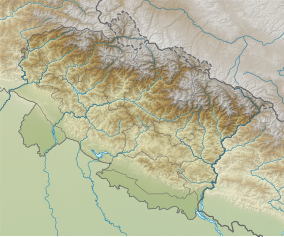Rajaji National Park
This article needs additional citations for verification. (April 2012) |
| Rajaji National Park | |
|---|---|
| Location | Uttarakhand, India |
| Nearest city | Haridwar and Dehra Dun |
| Coordinates | 30°03′29″N 78°10′22″E / 30.05806°N 78.17278°E |
| Area | 820.5 km2 (316.8 sq mi) |
| Established | 1983 |
| Governing body | Principal Chief Conservator of Forests, Uttarakhand |
| Website | junglesafarirajajinationalpark |
Rajaji National Park is a national park and tiger reserve in the Indian state of Uttarakhand.[1] that encompasses the Shivaliks, near the foothills of the Himalayas. It covers 820 km2 (320 sq mi)[2] and is included in three districts of Uttarakhand—Haridwar, Dehradun and Pauri Garhwal. In 1983, three wildlife sanctuaries in the area (namely, Chilla, Motichur and Rajaji) were merged into one.[2]
Rajaji National Park was named after C. Rajagopalachari (Rajaji), a prominent leader of the Freedom Struggle, the first and last Governor-General of independent India and one of the first recipients of India's highest civilian award, Bharat Ratna (in 1954).
History
[edit]In 2015, the government approved a proposal to grant Rajaji National Park the status of a tiger reserve.[3] As per directions of the Tiger Conservative Authority of India, its core area is Rajaji National Park, whilst about 300 km2 (120 sq mi) of the Shyampur range of the Haridwar forest division and parts of Kotdwar and Laldhang forest division are also included, augmenting the total area to 1,150 km2 (440 sq mi).[citation needed]
Flora
[edit]Rajaji National Park is nestled between the Shivalik ranges and the Indo-Gangetic plains. Broadleaved deciduous forests, riverine and riparian vegetation, scrubland, grasslands and pine forests form the range of botanical habitats in the park. The understory is sparse, and often absent, consisting of rohini (Mallotus philippensis), amaltas (Cassia fistula), shisham (Dalbergia sissoo), sal (Shorea robusta), palash (Butea monosperma), arjun (Terminalia arjuna), khair (Senegalia catechu), baans (Dendrocalamus strictus), semul (Bombax ceiba), sandan, chamror (Ehretia), amla Phyllanthus emblica, kachnar (Bauhinia variegata), ber (Ziziphus mauritiana), chilla (Casearia), bel (Aegle marmelos).
Fauna
[edit]
Over 315 species of birds occur in the park, including both residents and migrants.[2]
Rajaji National Park is at the northwestern limit of distribution for both the Indian elephant and Bengal tiger in India. The goral and the Himalayan tahr are also noteworthy residents, mainly staying on the precipitous, pine-covered slopes. Chital herds sometimes number 250 individuals. sambar deer, swamp deer, Northern red muntjac, Indochinese hog deer, nilgai, wild boar and sloth bear also occur in the park, and rhesus macaque and the common langur are common. The Bengal tiger and Indian leopard are the prime predators in Rajaji National Park, apart from leopard cat, jungle cat, dhole, several viverrine species, Bengal fox, golden jackal and yellow-throated marten. The Himalayan black bear inhabits the higher reaches of the park. Other wild animals in the park include Bengal monitor, Brahminy blindsnake, Burmese python, Common krait, Hanuman langur, Indian cobra, Indian crested porcupine, Indian flying fox, Indian grey mongoose, Indian hare, king cobra, Oriental garden lizard, Rhesus macaque, Russell's viper, smooth-coated otter, white-bellied giant flying squirrel.
References
[edit]- ^ "National Tiger Conservation Authority".
- ^ a b c Rajaji Official website of Haridwar.
- ^ "Rajaji becomes second tiger reserve in Uttarakhand". Hill Post. 2015.


